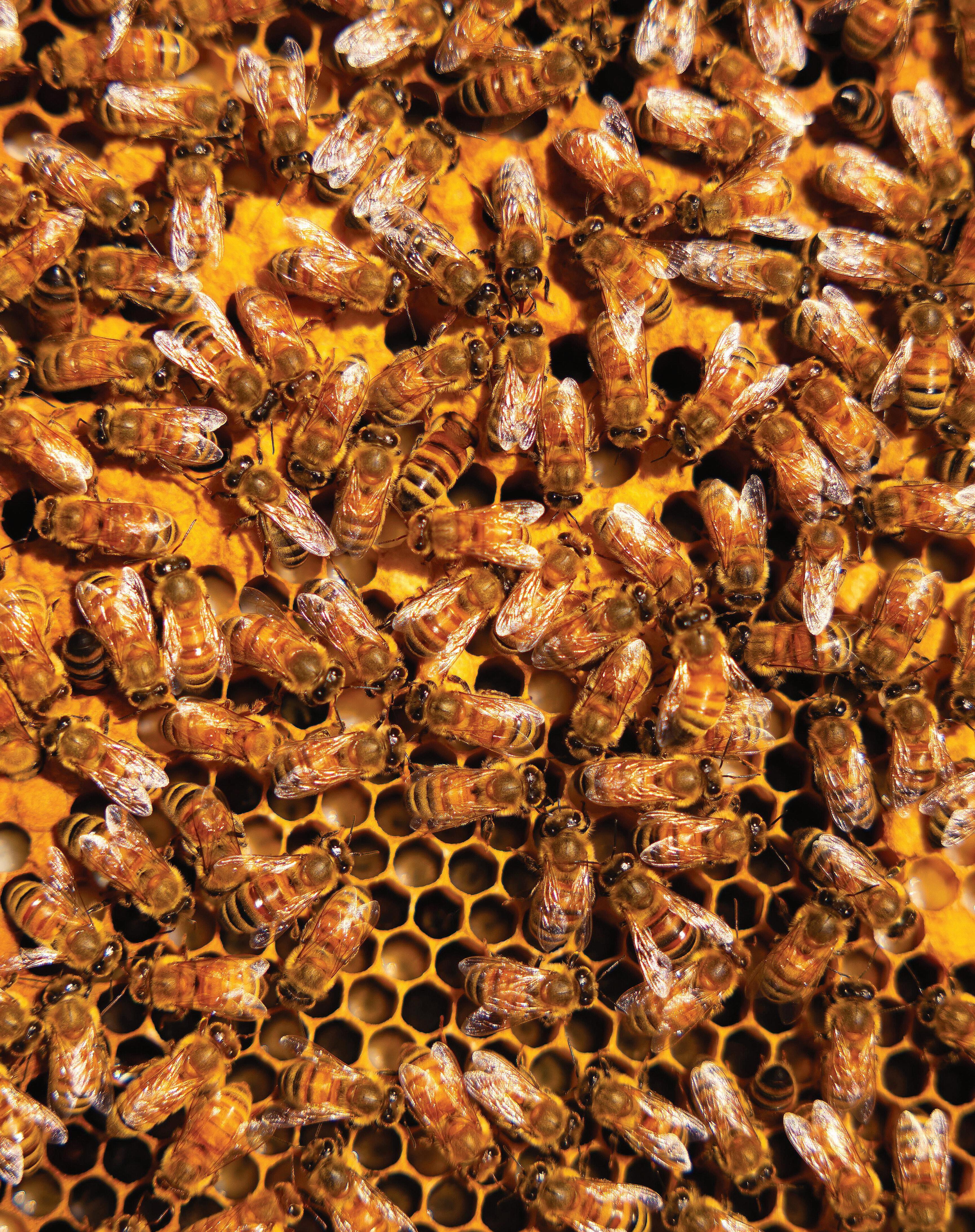
BUZZING WITH PURPOSE GRIDIRONS TO GREENHOUSES
GRILLIN’ AND CHILLIN’

HOME OF IOWA’S

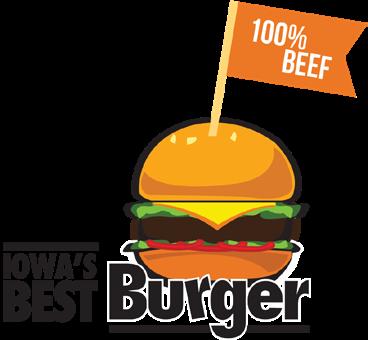

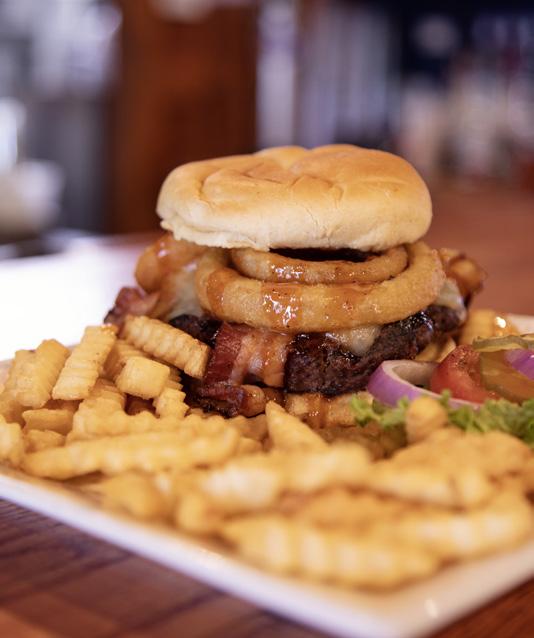



























IN THE SUMMER ISSUE OF FRESH PICKINGS MAGAZINE, YOU’LL FIND STORIES THAT CELEBRATE THE INCREDIBLE FOOD, FARMS AND FAMILIES THAT MAKE IOWA A SPECIAL PLACE TO LIVE.
THIS QUARTERLY PUBLICATION IS BROUGHT TO YOU BY THE IOWA FOOD & FAMILY PROJECT. WE ARE AN INITIATIVE THAT INVITES IOWANS TO EXPLORE HOW FOOD IS GROWN AND RAISED AROUND THE STATE AND MEET THE FARMERS WHO MAKE IT HAPPEN, 24/7, 365 DAYS A YEAR.
WE NETWORK WITH NEARLY 35 FOOD, FARMING AND HEALTHY LIVING ORGANIZATIONS THAT ARE PROUD OF IOWA’S HOMEGROWN FOODS AND HOMETOWN VALUES. YOU CAN LEARN MORE ABOUT OUR PARTNERS ON PAGE 5.
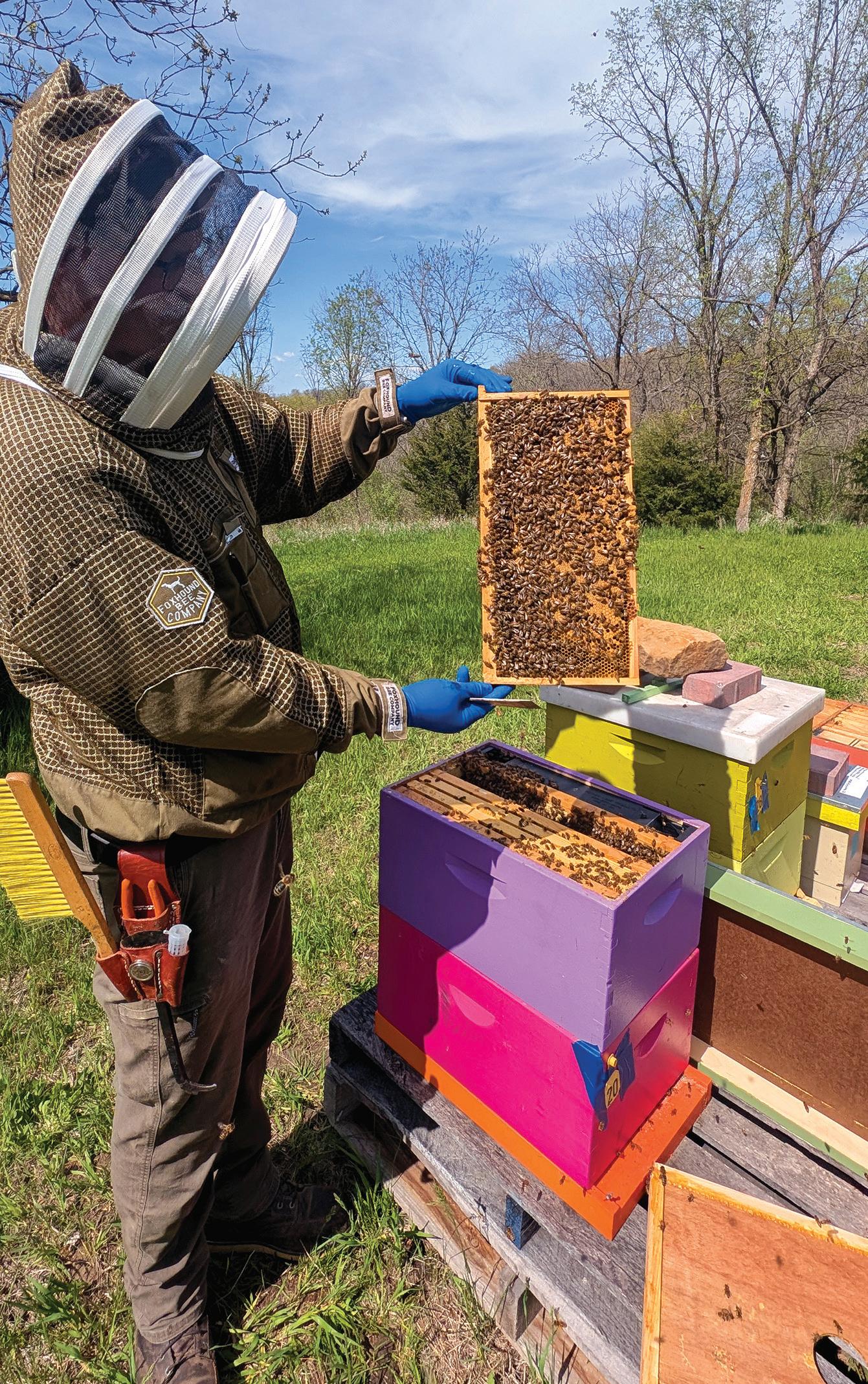
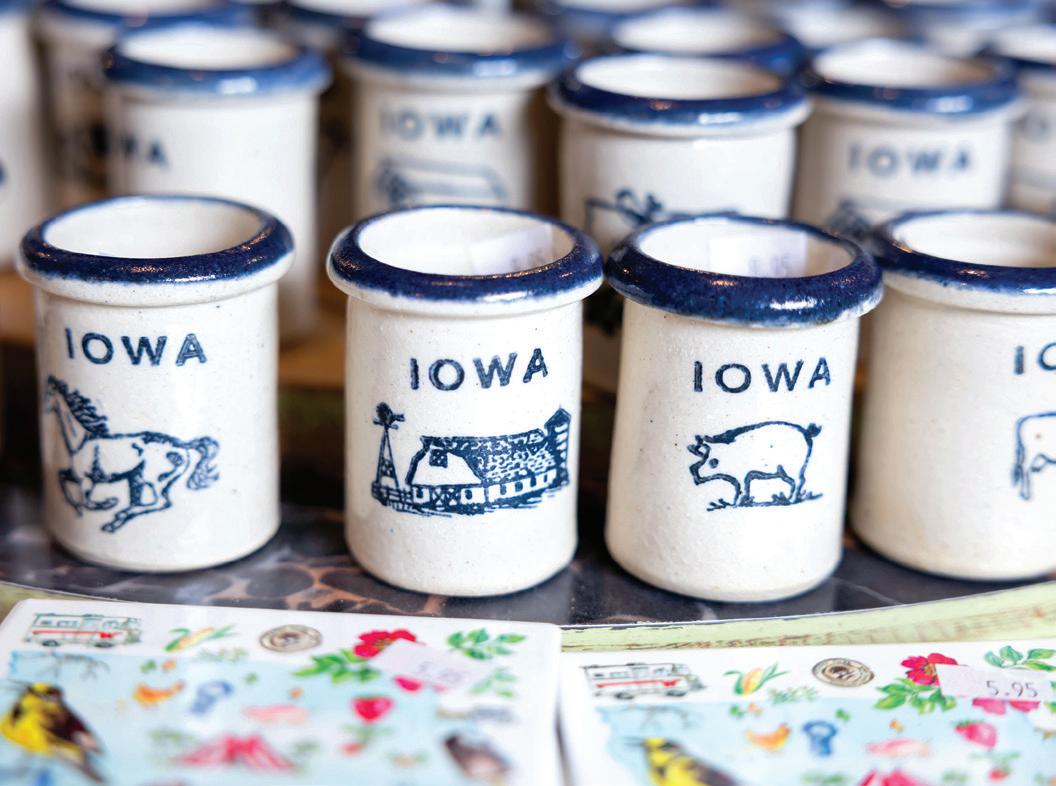
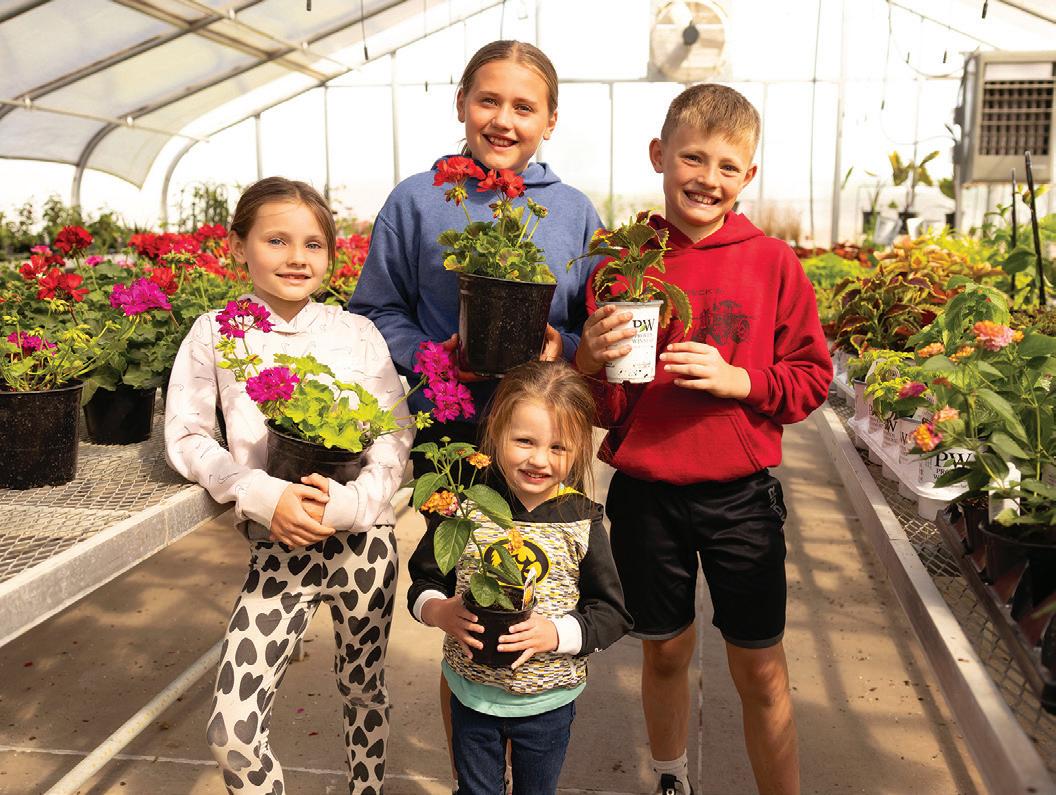
14
For Iowa beekeepers, the impact goes far beyond the hive. Meet four Iowans who are saving bees, sharing honey and building community along the way.
20 FROM DAIRY BARN TO BARN HAPPY
What started as a cowshed in 1925 is now a charming restaurant and boutique boasting Iowa fares and wares.
While Iowa is a leader in ag production, Ames also boasts a modern feed mill that’s a game changer for the global grain industry.
28 GRIDIRONS AND GREENHOUSES
Kroul Farms, a multigenerational farming operation, seeks to remain true to its roots while embracing new opportunities.

34
GRILLIN’ AND CHILLIN’
Whether you’re firing up the grill or chilling on the patio, we share Iowa-inspired recipes that bring the fun — and the yum.
38 AN ILLUMINATING PAST. A BRIGHT FUTURE.
7
EDITOR’S NOTE COORDINATED CHAOS
8
FAMILY TABLE THE SIZZLE IN YOUR SALAD
12
34 ON THE COVER
When the Kuypers invested in the Rolscreen retractable screen in 1925, they opened a window of opportunity for American manufacturing and community impact.
42 FARMING + IMAGINATION + SCIENCE
What if your next tank of fuel helped clean the air, support Iowa farmers and lower food costs? Learn how biodiesel from soy and corn does exactly that — naturally, renewably and powerfully.
POINT OF INTEREST GREAT REVIVALIST BREWERY
48 FRESH PICKED TURNING EXCESS INTO OPPORTUNITY
A single honeybee hive can house up to 60,000 bees during peak season. Each bee plays a vital role — whether gathering nectar, making honey, caring for young or protecting the hive.



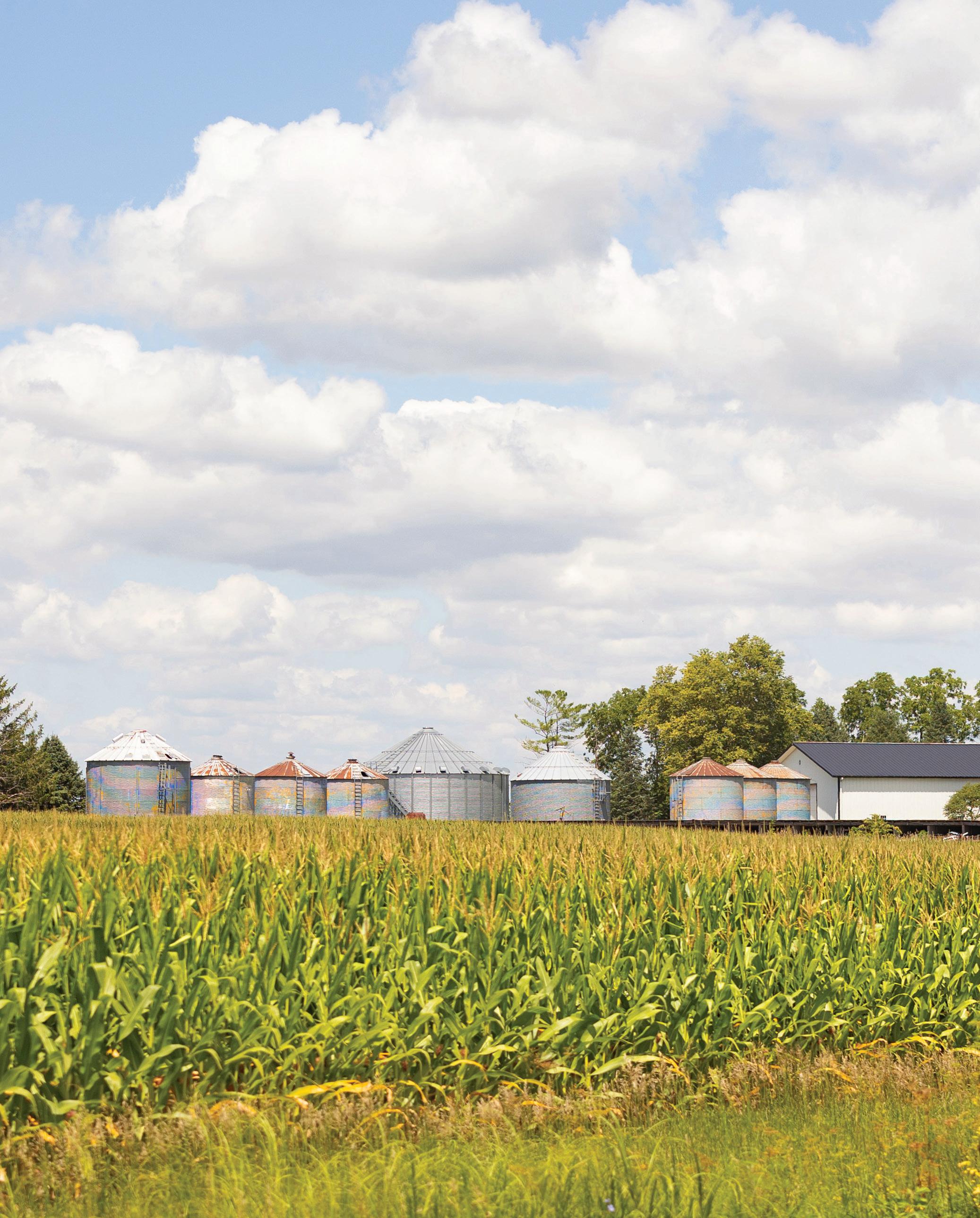

BROUGHT TO YOU BY THE IOWA FOOD & FAMILY PROJECT
EDITOR
LYDIA ZERBY
PHOTOGRAPHER
JOCLYN KUBOUSHEK
DESIGNER
BRIANNA SCHECHINGER
WRITER
AARON PUTZE, APR
APRIL PEARSON
April Pearson Creative
CRISTEN CLARK
Food & Swine
DARCY MAULSBY
Darcy Maulsby & Co.
HALEY BANWART
Farm Roots & Chore Boots
CAROLINE SCHULTZ
Wixted & Company
GRETCHEN WESTDAL CENTERS
GWC Creative
LEAH BROOKE
ISU Extension and Outreach
FOUNDERS
Iowa Soybean Association
Iowa Beef Industry Council
Iowa Pork Producers Association
Midwest Dairy
Iowa Corn Growers Association
Iowa Poultry Association
Iowa Egg Council
Iowa Turkey Federation
The Soyfoods Council
SUPPORTERS
Anderson Erickson Dairy Cargill
Cookies Food Products Corteva Agriscience
Earl May Garden Centers
Farm Credit Services of America
Heart of America Group
Hy-Vee
Iowa Grocery Industry Association
Iowa Machine Shed Restaurant
Iowa State Fair
Key Cooperative
Latham Hi-Tech Seeds
Live Healthy Iowa Subway
REQUEST YOUR MAILED SUBSCRIPTION AT IOWAFOODANDFAMILY.COM/MAGAZINE/SUBSCRIBE
Thank you to the Iowa Soybean Association, Iowa Beef Industry Council, Iowa Pork Producers Association, Midwest Dairy, Iowa
Corn Growers Association, Iowa Egg Council, Iowa Turkey Federation, Farm Credit Services of America, Cargill, Corteva Agriscience, Key Cooperative, Latham Hi-Tech Seeds, Live Healthy Iowa and Earl May for the financial investment that makes this publication possible.
Fresh Pickings is published four times a year by: Iowa Soybean Association, 1255 SW Prairie Trail Parkway, Ankeny, Iowa 50023
For advertising information, complete the form at iowafoodandfamily.com/magazine/feedback
Advertising space reservations must be made through the above form. In consideration of the acceptance of the advertisement, the agency and advertiser must, in respect of the contents of the advertisement, indemnify and save the publisher harmless against any expense arising from claims or actions against the publisher because of the publication of the content of the advertisement.
Comments: iowafoodandfamily.com/magazine/feedback
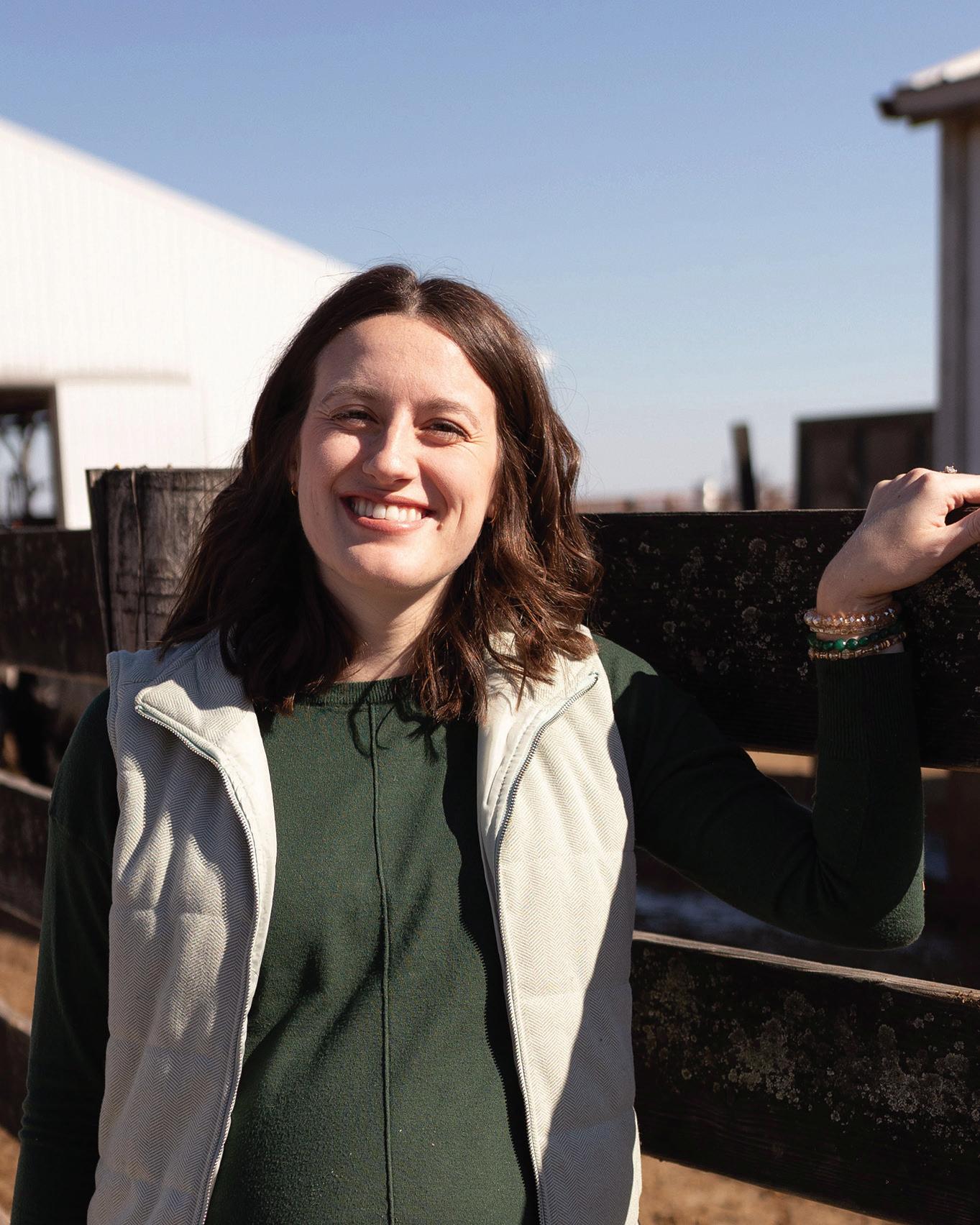

Livestock feed is the largest market for Iowa soybeans. Through the checkoff, we’re helping to grow this established market and support our state’s livestock industry with quality soy protein.

Investing in new uses gives my soybeans more value and increases demand. More research and business leaders are realizing how soy can improve the performance and sustainability of their products – that’s a win for farmers and consumers alike.
RANDY MILLER


Summer has a way of sneaking up on us. One minute, we’re braving the final stretch of the school year, and the next, we’re knee-deep in sunscreen, sand, snack wrappers and those spontaneous “Mom, can we have a lemonade stand today?” moments. Calendars that were once color-coded with care now resemble a game of schedule Jenga — trying to fit in swim lessons, sports practices, playdates, family vacations and maybe a moment to catch our breath.
It’s a beautiful kind of chaos. The kind where memories are made — sticky popsicle fingers, spontaneous sprinkler runs and backyard dinners that stretch into the evening. It’s not always smooth or perfectly planned, but somehow, it all comes together.
That same spirit of controlled chaos plays out every day in a different corner of Iowa life — on our farms and in our food production facilities. While we’re juggling carpools and camp drop-offs, farmers are up before dawn,
watching the weather, troubleshooting equipment, managing livestock and navigating a dozen unpredictable variables. From droughts to downpours, market shifts to labor needs, their daily to-do lists are anything but routine.
And yet, just like our summer schedules, it all comes together. Because it must. Food doesn’t take a vacation. Livestock still need care. Crops still grow. Iowa’s farmers and producers are the ultimate multitaskers, balancing science, skill and instinct with a deep-rooted commitment to feeding and caring for others. It’s a different kind of chaos, but one that serves our families and communities every single day.
In this issue of Fresh Pickings, we’re embracing the hustle of summer and shining a light on the people who manage their version of summer madness with remarkable grace and grit. From the sweet corn at your picnic table to the beef sizzling on your grill, we invite you to celebrate the hardworking hands behind the food — and slow down just long enough to savor it.
Here’s to a summer full of flavor, fun and a little well-coordinated chaos.
Enjoy the issue,

Experience craft beverages in a reimagined historic church. Enter to win at iowafoodandfamily.com/contest/great-revivalist .
By Cristen Clark

Steak salads are more than just a popular meal — they’re a smart, flavorful way to enjoy the many benefits of cooking with beef. Combining bold and savory grilled steak and vegetables with the crisp freshness of salad greens creates a satisfying, nourishing dish. To enhance this meal, consider the cut of steak. Skirt steak is a cut I was introduced to many years ago by a friendly meat counter associate when flank steak was unavailable. I absolutely love skirt steak for its flavor and tenderness, and it’s the perfect cut for this salad.
Iowa beef is one of the most nutrient-dense proteins you can add to your plate. Just a single serving of lean steak provides high-quality protein, iron, zinc and B vitamins — nutrients that support energy levels, immune function and muscle health. When paired with colorful garden staples like red onion, bell pepper and sweet corn, plus healthy fats like avocado, steak salads become a well-rounded meal that fuels your body and satisfies your taste buds.
One of the biggest advantages of steak salads is their versatility. This recipe can transform into a savory bowl with a base of quinoa, brown rice or orzo. With a quick drizzle of a cilantro-lime
vinaigrette, you have a completely different take on a protein-packed power meal. This recipe is easy to prepare, making it perfect for busy weeknights. With just a few minutes on the grill, the skirt steak and vegetables can be perfectly cooked. While the steak rests, you can toss together the salad — minimal prep, maximum flavor. It’s a practical option for families who want to eat well without spending hours in the kitchen.
Kids who may be hesitant about vegetables often enjoy this steak salad thanks to the familiar and appealing flavor of the meat, along with grilling some of the vegetables to round out the flavor. When presented with colorful toppings and fun textures, salad becomes a more exciting and approachable meal for everyone at the table. To get a little extra protein, you could add a hard-boiled egg or two to each serving.
Whether you’re trying to eat healthier, cook at home more or simply add variety to your meals, steak salads are a winning choice. They’re nutritious, adaptable and undeniably delicious. It’s a meal that brings everyone together, one flavorful bite at a time.
• 1–1½ pounds skirt steak
• 2 teaspoons seasoned salt of choice
• 1 teaspoon chili powder
• 1/2 teaspoon dried oregano leaves
• 2 tablespoons vegetable oil
• 1 large red onion, peeled and cut into 8 wedges
• 2 small or one large bell pepper(s)
• 2 large or 3 small ears of sweet corn, shucked and silks removed
• Salt and pepper to taste
• 6–8 cups chopped lettuce, baby red leaf and arugula (or romaine, spring mix or combination)
• 1½ cups cherry tomatoes, halved
• 1 avocado peeled, sliced or chopped in bite sized pieces
GARNISH
• 1/4 cup chopped fresh herbs (a combination of parsley and chives)
• 1/2 cup queso fresco or feta cheese, crumbled
• Southwest salad dressing of choice
Preheat the grill to medium-high heat. Sprinkle seasoned salt, chili powder

and oregano leaves over the skirt steak. Brush oil on the onion slices, bell pepper and sweet corn, then season with salt and pepper.
Place the steak and vegetables on the grill. Flip the steak after 5 minutes and rotate the vegetables. Continue grilling for another 4 to 5 minutes. When the steak reaches an internal temperature of 140 degrees F, remove it from the heat and let it rest. Remove the vegetables when they are lightly charred and softened. Cut the bell pepper into 1- to 2-inch pieces and slice the corn kernels off the cob.
Meanwhile, arrange the lettuce, grilled corn, grilled peppers, grilled onions, cherry tomatoes and avocado on a platter. Slice the steak thinly against the grain and place it on top. Garnish with fresh herbs, cheese and your choice of salad dressing. Serve immediately.
Makes 4 salads.


Craving adventure beyond the ordinary? Look no further than rural Iowa communities. Ditch the typical vacation and take the road less traveled into the heart of Iowa’s small towns. Beyond the rolling hills and cornfields, you’ll experience authentic relationships, discover the fascinating evolution of the heartland, and leave with a whole new perspective of Iowa.
Choose the sites you want to see. Determine your path (Iowa’s by-ways are a great way to get off the beaten path and enjoy the scenic views).
3. Download an Iowa Passport.
4. Check out other travel resources at www.traveliowa.com.
5. Follow Evolution of the Heartland on social.
Experience Indianola and Wander Warren County - where hot air balloons grace the skies and agri-ventures fill your day.
• Bochner Farms
• Edge of the Woods Berry Farm




Clear Lake
LIMITED SPOTS AVAILABLE!
Experience Clear Lake from a fresh perspective behind-the-scenes during this immersive one-day tour that celebrates Iowa’s rich agricultural roots.
• Surf Ballroom Music & Memorial Crop Tour
• Mossycup Farms** Tour
• Central Gardens
• Lake Time Brewery
Make it a weekend experience and enjoy:
• Saturday Farmers Market at the Surf Ballroom
• Live music at Thursdays on Main
• Tastings at Lake Time Brewery & 173° Craft Distillery

• Honey Hollow Apiary & Gardens
• Rose Farm
• Wilson’s Orchard & Farm From farm-fresh flavors and hands-on fun to local honey and seasonal outings, there’s no shortage of ways to explore. Be sure to plan a stop on Indianola’s Downtown Main Street - with charming boutiques, quaint cafes, and locally brewed libations.

LIMITED SPOTS AVAILABLE!
Experience a one-day, immersive Iowa adventure in Osage. Explore the fields and flavors of Twisted River Farm**; sip and savor at Limestone Brewing; and enjoy a private dining experience at Taste**. Make it a weekend:

• Explore outdoor recreational activities at the Mitchell County Conservation
• Autumn Artistry featuring local artists and artisans, antiques, décor, delicious foods, live music, a farmers market, and more

Discover the small-town charm of Iowa Falls, a picturesque Main Street community.
• Taste clean ingredients fresh from the garden at GodFuel


• Cruise the Iowa River on the Scenic City Empress
• Savor local flavors at Nimrod Meats
• Explore Calkins Nature Area
Don’t miss the vibrant downtown featuring








Take the road less travelled, get off the beaten path and find a hidden gem.
Pick fresh flowers, pumpkins, or produce at a u-pick farm.
Meet Iowans (We really are “Iowa nice”!) Bonus points if you meet an Iowa farmer!
See how you measure up to Iowa corn (or soybeans).
Taste fresh, locally-grown foods.
Shop in a small town and support a local business owner.
Celebrate the American Dream and visit a Freedom Rock. (There’s one in every county!)
Sleep under the stars and wake up to an Iowa sunrise.
Make memories that last a lifetime!



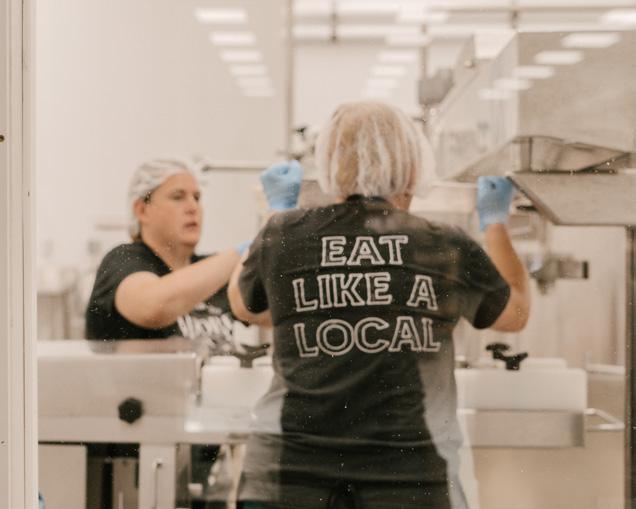
Discover more rural communities and agritourism adventures. Request a brochure or explore the digital map to start planning your unforgettable Iowa road trip today! www.evolutionoftheheartland.com/agritourism


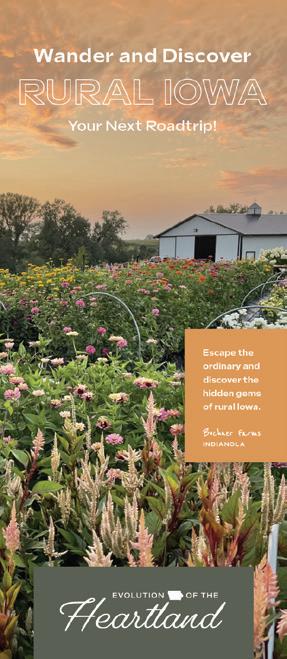


The smoky flavor from the woodfired oven adds a distinctive depth to signature pizzas that can’t be achieved with conventional cooking methods.

In 1911, Italian artisans erected this floor-to-ceiling mosaic entitled “The Light of the World.”

Great Revivalist is the only microbrewery in the area which pasteurizes their products and cans them as well.
By Haley Banwart

Across small-town Iowa, it’s not uncommon for historic buildings — schools, churches and gathering spaces — to sit vacant, slowly falling into disrepair before they’re eventually torn down. But it’s not just the structure that disappears; it’s a piece of local history and culture quietly lost.
One 19th-century church in Clinton seemed destined for that same fate, until salvation struck in an unexpected form. Today, the former St. John’s Episcopal Church is home to Great Revivalist Brewery (GRB), a thriving community hub where the past is celebrated and new memories are poured.
After operating out of a strip mall in Geneseo, Illinois, brewery owner Richard Schwab was ready for something different. He wanted a space with character, an older building with good bones and a story to tell.
Schwab’s search ended in 2022 when he toured a striking Gothic Revival church that had been sitting empty for three years, waiting for its next chapter. Recognizing
its architectural beauty and historical significance, Schwab and his team embarked on an ambitious two-year restoration project.
Hardwood floors were unearthed beneath layers of red carpet and plywood. Brick walls were exposed, and original materials were repurposed wherever possible. Pews turned into tables, a pipe organ became wall art and a hand-crafted 1911 mosaic of hammered gold was preserved in its original place.
“We tried to restore the church to its former glory,” says Rachel Heise, GRB general manager. “While the stained glass in the main dining room was updated in the 1970s, some original pieces from 1898 still remain throughout the building. The 1910 grand piano is still in use, and the gargoyles were added to complement the Gothic architecture.”
“A lot of what’s here was either preserved or brought in to reflect the church’s historic and period details,” she adds.
While the dark and moody interior creates a sense of grandeur, the brewery’s
courtyard offers an inviting outdoor escape. Anchoring the space is a 48,000-pound marble replica of the Trento Cathedral fountain in Italy, complete with hand-carved cherubs, dolphins and shells.
A towering magnolia tree adds to the courtyard’s sense of permanence and charm. “It’s a beautiful space to relax with a drink, share conversation or enjoy live music,” Heise shares.
Great Revivalist brews its beer on-site, offering a wide selection of styles — from light lagers to dark stouts and crisp ciders. They’re also expanding into seltzers and serving non-alcoholic options, including craft sodas, energy drinks and nitro cold brew coffee.
The brewery’s wood-fired pizzas are a crowd favorite, made from scratch and cooked in an oven visible from the main dining area. Downstairs, the basement serves as a private event space for up to 104 guests, with in-house catering available.
With so many guests curious about the unique decor and artifacts, the brewery created the GRB Bible. This selfguided online tour tells the story behind features like the former sermon podium now used as a host stand.
“People notice something new every time they visit,” Heise says. “We put our heart and soul into the space, and we’re always adding to it.”
By Caroline Schultz
In the heart of Iowa’s farmland, amid cornfields and livestock pastures, a quieter form of agriculture is buzzing with life. From backyard hives to full-scale apiaries, local beekeepers are not just harvesting honey — they’re nurturing ecosystems, mentoring veterans, bonding with family and building connections jar by jar.
Meet Michelle and Steve Wearmouth, Mike Peverill and Chris Coppinger, beekeepers whose journeys are as rich and layered as the honey they produce. Their stories offer a personal glimpse into what it means to be a modern-day beekeeper in Iowa, a role that is equal parts scientist and steward.
From Hobby to Healing: Wearmouth Apiary and BeeWear Honey
What began as a hobby with two struggling hives has grown into a retirement dream and therapeutic mission for Michelle and Steve Wearmouth. “We didn’t know what we were doing at first. It was a total failure,” Michelle says.
But everything changed when they joined the Friendly Beekeepers of Iowa, a club that turned them from novices into mentors. Today, the Wearmouths give back through Hives for Heroes, a nonprofit organization that helps veterans with PTSD find purpose through beekeeping. “It gives them something to focus on, something healing,” says Michelle. “We’ve come full circle.”

The Wearmouths now manage 61 hives and, in 2024, produced 1,700 pounds of honey. They’ve gone beyond traditional honey to create

THERE ARE AN ESTIMATED 4,500 BEEKEEPERS IN IOWA MANAGING OVER 45,000 COLONIES AND PRODUCING ABOUT 4 MILLION POUNDS OF HONEY ANNUALLY.
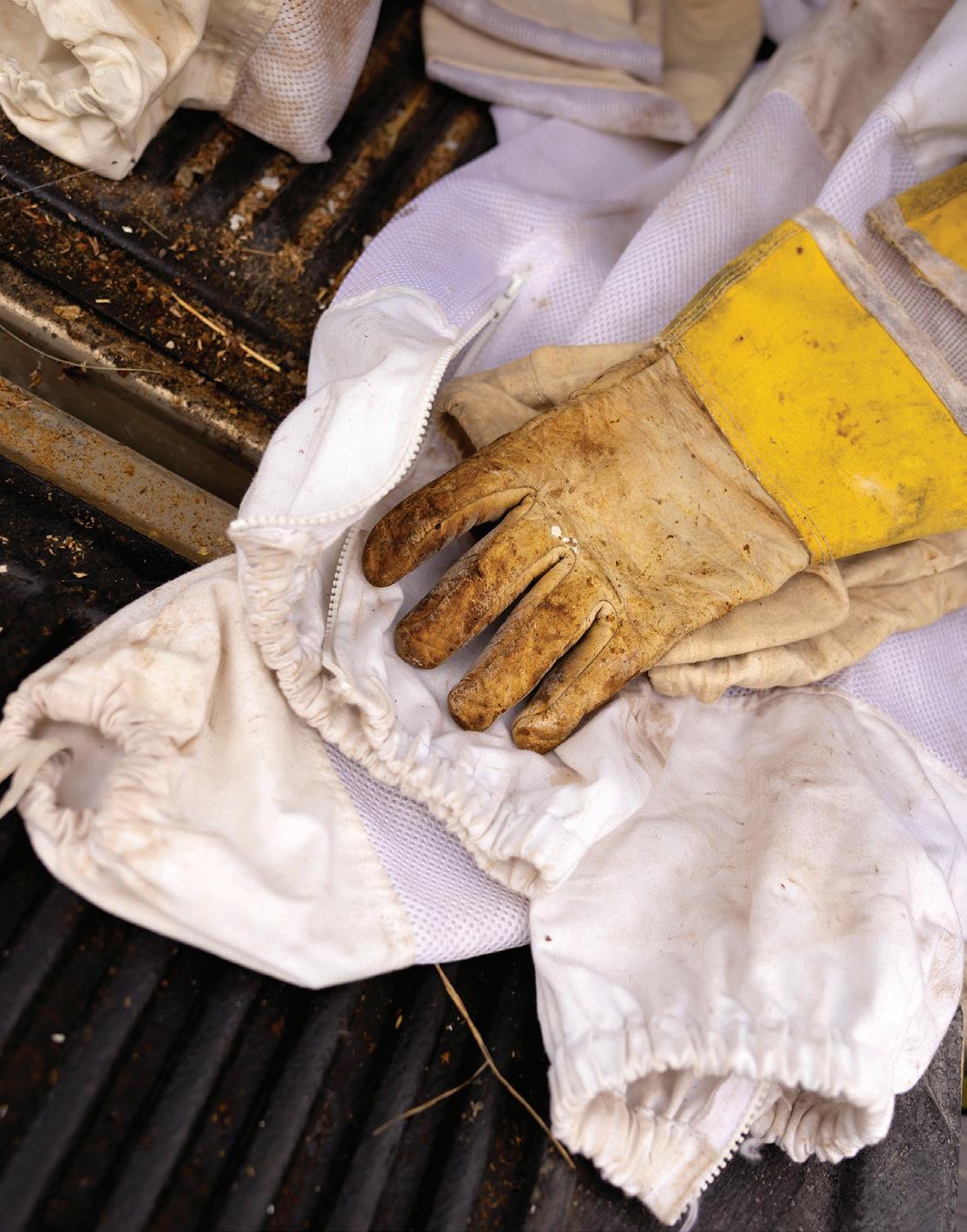

flavored varieties like blueberry, lemon and crowd-favorite hot honey, made with just two natural ingredients. “Honey is more than a sweetener,” Michelle says. “It’s part of a whole agricultural cycle. We’re farmers, just like anyone raising livestock.”
Their approach is methodical and respectful, mirroring lessons in patience, resilience and care. “You don’t just learn how to manage bees,” Michelle says. “You learn how to manage life.”
Urban Buzz: Peverill’s Apiary and Backyard Beekeeping
Mike Peverill didn’t grow up dreaming of becoming a beekeeper. The spark came from a TV show on off-grid living. “I thought, if they can do it, heck, I can do it,” he remembers. That passing idea turned into a passion. He took a beekeeping course through Des Moines Area Community College, joined local clubs and grew his operation beyond his backyard.
Mike now manages hives in nearly 40 urban yards across Des Moines, thanks to a unique Hive Hosting program. “These are people who love bees but don’t have the time or experience. So, they host hives, and we take care of the rest.”
This unconventional model is working so well that Mike’s biggest challenge isn’t beekeeping anymore. “It’s bottling honey and staffing farmers’ markets,” he laughs. His product line includes fresh honey and honey lemonade, sold primarily at bustling farmers’ markets, where customers crave that hyper-local, raw sweetness.
For Mike, beekeeping isn’t just about honey; it’s about sustainability and community. “Bees are a gateway to learning how everything’s connected,” he says. “If you support the bees, you’re supporting the whole food system.”
Honey and Homecoming: Sugar Creek Honey
Chris Coppinger never set out to become a beekeeper. He just wanted to spend time with his daughter. “We were at the Iowa State Fair when she pointed out a scholarship program. I said, ‘Sure, write the essay.’
“BEES ARE A GATEWAY TO LEARNING HOW EVERYTHING’S CONNECTED. IF YOU SUPPORT BEES, YOU'RE SUPPORTING THE WHOLE FOOD SYSTEM.”

Hives for Heroes is a national movement dedicated to connection, purpose and service through beekeeping. Focusing on sustainability, conservation and providing a healthy transition from service, this nonprofit serves service members, veterans and first responders. There are over 70,000 hives, 7,800 heroes and mentors, and more than 3.5 billion bees in the Hives for Heroes network.
Learn more and purchase Heroes Honey at hivesforheroes.org.


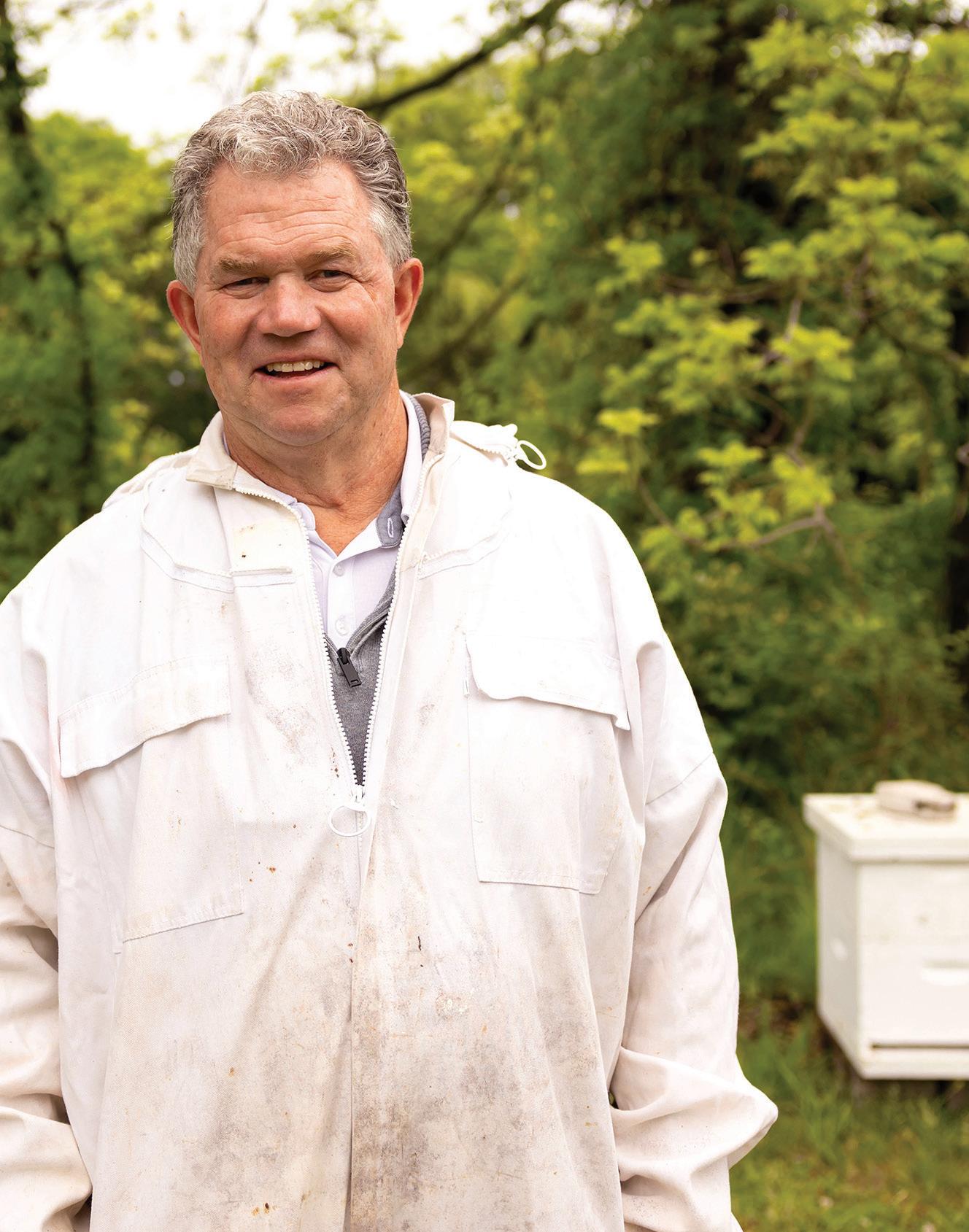
The next thing I knew, we were in beekeeping classes. By the second one, I was hooked.”
That father-daughter project soon turned into a full-on obsession, for Chris, at least. “She dropped out after getting stung on the thigh. Didn’t want to risk the face before homecoming,” he said. But Chris kept going, expanding to eight hives, buying his own honey spinner and diving deep into bee biology.
His fascination is infectious. “Every bee has a job: some cool the hive, some clean, some build. The queen lays up to 2,000 eggs a day. If she slows down, they make a new queen. It’s wild.”
Nowadays, Chris says he spins honey with friends, filters it with care and gives his branded Sugar Creek Honey away as holiday gifts. “That’s what it’s about — connection,” explains Chris.
One thing is clear about local Iowa beekeepers: The impact goes far beyond the hive. Bees are essential pollinators for crops such as apples, almonds and soybeans. Without them, agriculture as we know it doesn’t function.
“Pollination is often invisible,” says Michelle Wearmouth, “but it’s critical. Even dandelions play a role in feeding pollinators early in the season. That’s why movements like encouraging homeowners to mow less in May are gaining traction across Iowa.”
Whether it’s helping veterans heal, transforming backyards into bee havens or bonding with a daughter over honey, these Iowans are proving that beekeeping is more than a hobby — it’s cultivating community and a deep care for nature.

full of locally produced honey products from Peverill’s Apiary. Enter to win at iowa foodandfamily. com/contest/ honey .
HOW A HUMBLE HUNDRED-YEAR-OLD OUTBUILDING BECAME A CUTE AND COZY CAFÉ
By April Pearson

The idea for Barn Happy came to Kris Boettger almost in a dream over 20 years ago. She and her husband live on an acreage in Cedar Falls — complete with seven outbuildings — with their two kids. “My husband is a minister, so he was making very little money, and I was a stay-at-home mom, so I was making no money,” she says. They started raising hogs in the old dairy barn to afford the property.
As her kids grew up and started school, Boettger began looking toward her next chapter in life. “I told my husband I wanted to do something with people,” she says. “I’m highly extroverted, so I love being in the mix.” She prayed on it, then experienced an epiphany. “One night, when I was just about asleep, it came to me: Take the dairy barn and turn it into a people place!”


“I could sell coffee, homemade baked goodies and things made in Iowa! I told my husband, and he suggested praying a little longer,” she laughs. “He knew it would be hard.”
Eventually, they decided to move forward with Boettger’s idea, and the real work began. They spent a year cleaning out the dairy barn/ hog barn/restaurant. “It was an insane job,” she says. “There were six inches of packed manure on the floor, a ton of straw bedding for the hogs and — you know — whatever’s in an old barn built in 1925.” Lots of elbow grease and several gallons of bleach later, the barn was a sight to behold. This bright, spacious, pristine landmark is a reminder of days gone by.
As the business’s opening day drew near, one important detail was missing: What to call it?
Again, Boettger turned to prayer.
“I was trying to think of names, so I had this notebook, and I was writing down every possible name to describe us,” she says. “I was annoyed by this point, so I started praying and forgot about it. I was getting ready one morning, and suddenly thought: Barn Happy! It was boisterous in my head.”
Barn Happy opened in 2003 as a one-woman enterprise with modest offerings. Since then, it’s grown into a full-fledged business employing 20 people who keep the shop hopping and serve a full menu of culinary delights.
Barn Happy offers a variety of soups, sandwiches and quiche. They also have pies, pastries and a whole coffee and drink bar. The menu often depends on what’s in season.
Two women do most of the cooking for Barn Happy, and they’re both gardeners. One has chickens, and she uses their eggs to make pies and puddings. The other brings in fresh garden produce every week during the growing season.
“When we can add anything out of the garden, we love it,” Boettger says. “Last year, we did a potato asparagus soup and asparagus pasta salad in the spring, a cucumber-honeydew salad and
tomato-basil salad in the summer, and squash soup and apple Waldorf salad in the fall.”
What about the dairy for this old dairy barn? “There’s a local place in Hudson called Hansen’s Dairy, where we buy milk and cream to make our coffee drinks.”
Barn Happy has been voted The Courier’s “Best of the Best Gift Shop” in the Cedar Valley for three years in a row, and it’s easy to see why. In addition to seasonal gifts sourced from traditional retail channels, Barn Happy sells arts, crafts, antiques and treasures from more than 100 Iowa vendors.
It all started when Boettger met two women on the Taste of Iowa Board who showed her some of the unique products Iowans were making. Then she began attending the Iowa State Fair, lawn and garden shows, and local craft fairs. “I would always watch for creative things that I thought would sell,” she says.

These creative items include chenille chickens and cutting boards, lotions and soaps, socks and bibs, dish rags and hand towels, jewelry, candles, and books by local authors. If it’s a good product at a decent price, Boettger buys it outright to sell in the store with a small markup. “Artists and craftsmen deserve to get paid for their time and expertise,” she says. “Customers know that they’re paying for handmade, quality items.”
Barn Happy also stocks a multitude of tasty treats for creating custom gift baskets. “We have so many Iowa foods — granola, caramels, coffee, wine, popcorn, barbeque sauce and so forth,” says Boettger. “Many customers pick out what they want, then we arrange it nicely in a basket. It’s a great gift for those with everything because they can enjoy it and get a new basket of Iowa goodies next year.”
Boettger says that Barn Happy has the nicest customers in the entire

world. “People come here and say, ‘Thank you so much for being here! Please don’t ever close! I bring all my friends and guests here!’” she says. They appreciate the relaxing atmosphere, quality products and snapshot of Iowa’s agricultural heritage. What’s not to like? “We might get one grumpy person in 500, and then try to win that person over.” After all, it’s called Barn Happy, not Barn Grumpy.
The customers are happy and so are the workers. “I have the best staff,” she says. “Many have been here 10 to 15 years, and they just stick around. I trust them to care for things when I’m gone, so they’ve given me more flexibility. They’re just amazing.”
In the two decades since Boettger opened Barn Happy on her family’s acreage, the business remains committed to offering delicious local fare and quality local wares to their appreciative patrons. Boettger is focused on serving her community and family — never compromising on what’s important.


By Darcy Maulsby


When egg prices skyrocketed earlier this year, consumers started paying a lot more attention to the poultry industry. An innovative feed mill and grain science

complex south of Highway 30 in Ames also focuses on this critical ag sector, but this isn’t a typical Iowa feed mill.
“This facility is unique not only in America, but in the world,” says Dr. Dirk Maier, an Iowa State University (ISU) professor of agricultural and biosystems engineering who oversees the ISU Kent Feed Mill and Grain Science Complex.
Gone are the days when running a feed mill meant adding some corn and pushing a few buttons to make rations. Today’s high-tech, computerized mills require skilled operators to provide precision nutrition for livestock. ISU’s new $35 million feed mill complex, operational since September 2023, produces pathogen-free feed — free of harmful bacteria, viruses and parasites — using carefully controlled processes and ingredients that meet the highest standards of quality, nutrition and biosecurity to protect animal health and prevent disease.
The ISU mill supplies feed for a company that helps improve laying hens’ genetic potential — their inherited ability to produce high numbers of quality eggs safely and efficiently — and supplies baby chicks for customers worldwide. The mill
also produces pre-mixes (blends of vitamins and minerals mixed with grain and/or forage) for the beef and dairy industries.
“ISU is in a sweet spot in terms of crop production and the feed industry, not only in North America, but the world,” Maier says. “Our goal is to help the ag industry better meet modern animal nutrition needs.”
Iowa leads the nation in feed ingredients (29.1 million tons) that are fed to animals, primarily hogs, beef cattle and egg-layers. In addition, the state’s feed industry generates $16.5 billion in sales, according to the American Feed Industry Association. More than 45,000 jobs in Iowa are connected to the feed industry.
While Iowa has long been an epicenter of livestock and grain production, ISU lacked a modern feed milling facility for research, teaching and production for decades. “A lot of amazing things came together to make this new facility a reality,” Maier says.
Not only did ISU administrators see the vision, but donors did as well. Private funds financed 100% of the project. The name
The ISU Kent Feed Mill and Grain Science Complex sits just off Highway 30, on the edge of Ames.
of the ISU Kent Feed Mill and Grain Science Complex honors the lead donor, Kent Feeds, who is based in Muscatine.
Construction on the commercial feed manufacturing facility started in the fall of 2020 at ISU’s historic Curtiss Farm. Today, the complex includes a mill with a capacity of approximately 20,000 tons of feed per year and bins that can hold 200,000 bushels of grain. “About a third of the harvest from ISU’s research farms gets delivered here,” Maier says.
The main mill can run 12 hours a day, Monday through Friday. It uses a variety of ingredients, including soybean meal, soy hulls (for fiber) and soy oil, to make feed rations. “We don’t compete with the commercial feed industry,” Maier says. “We focus on custom production, specialty feeds and smaller feed batches for a variety of livestock.”
The mill complex also includes an educational building with classrooms. The facility allows graduate students to research areas from feed production to process engineering. In March 2025, a new pilot plant came
online at the complex. Maier says this smaller version of the main feed mill is invaluable for research.
About a dozen undergraduate students work at the main mill every week. ISU offers a minor in feed technology to prepare students to meet the growing demand for highly skilled, grain and feed industry professionals.
Minerals and feed additives are carefully measured and mixed to support livestock health and performance.
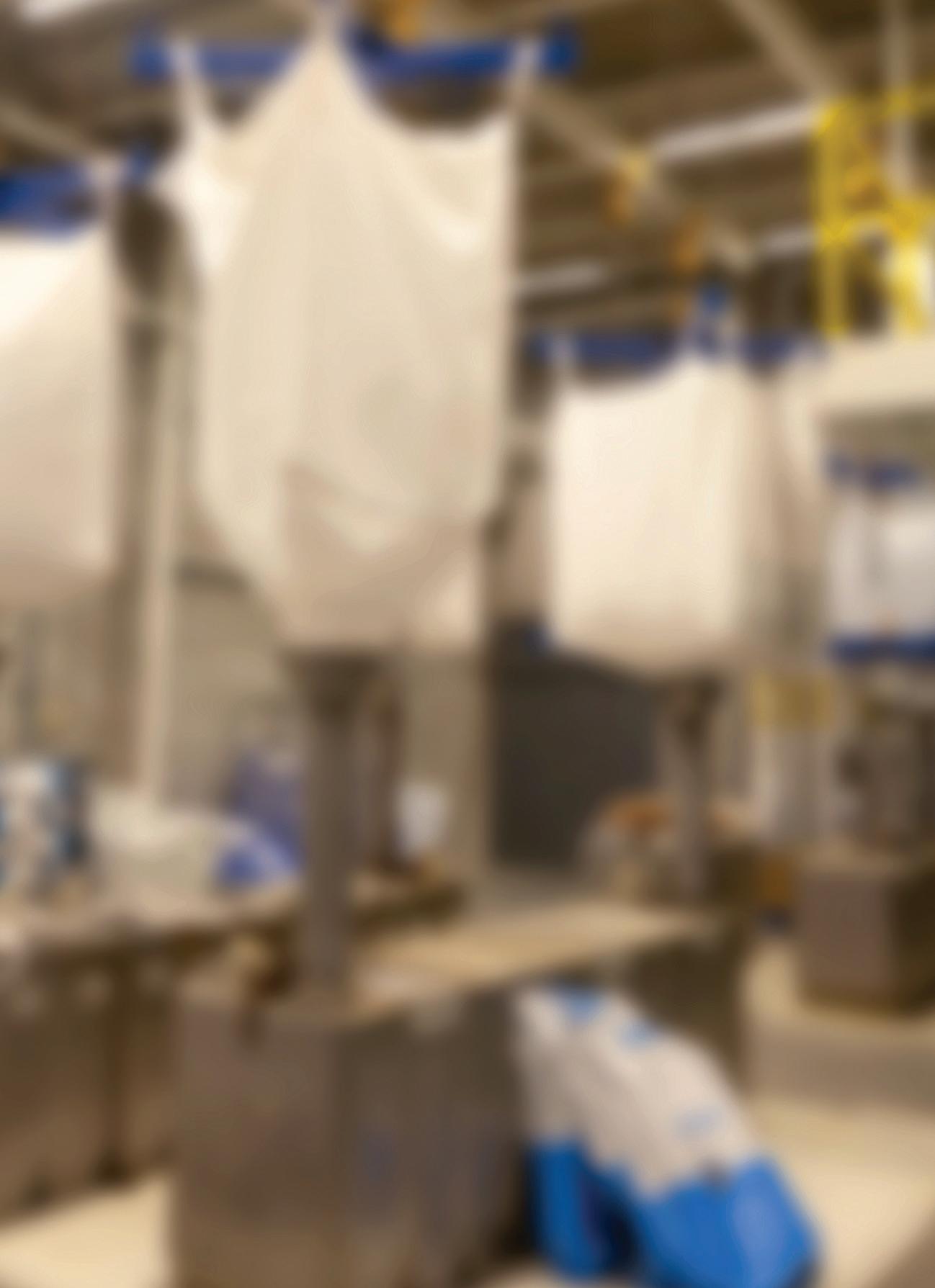

45,000
“This is like an apprentice program where you get practical, hands-on experience as you work, learn and earn,” Maier says. “This opens up a broad range of career opportunities for students majoring in animal science, engineering, finance, accounting, ag business and more.”
A Mill is a Game Changer for the Global Grain Industry
ISU’s state-of-the-art feed mill and grain-handling complex offers incredible potential to impact the grain industry on a global scale. In 2024, the facility welcomed more than 2,100 visitors from 26 countries in Asia, Latin America and beyond.
“No other university has something quite like this,” Maier says. “This facility allows us to work with groups like the Iowa Soybean Association and Iowa Corn to bring international teams from the U.S. Soybean Export Council and the U.S. Grains Council. We help them learn about Iowa agriculture, which helps develop more markets for Iowa ag products.”
Maier and his colleagues also hosted 136 different educational seminars, workshops and short courses in 2024. A variety of participants, including employees in the feed milling


and grain industries, come here to learn more about feed technology, grain science, animal nutrition, regulatory compliance issues, biosecurity and advanced processing methods.
ISU’s feed mill complex marks a big step forward in making food systems more secure and sustainable, all while making Iowa agriculture more competitive, Maier says. “This project has turned out even better than I thought — and we’re just getting started.”
generation of grain science professionals.
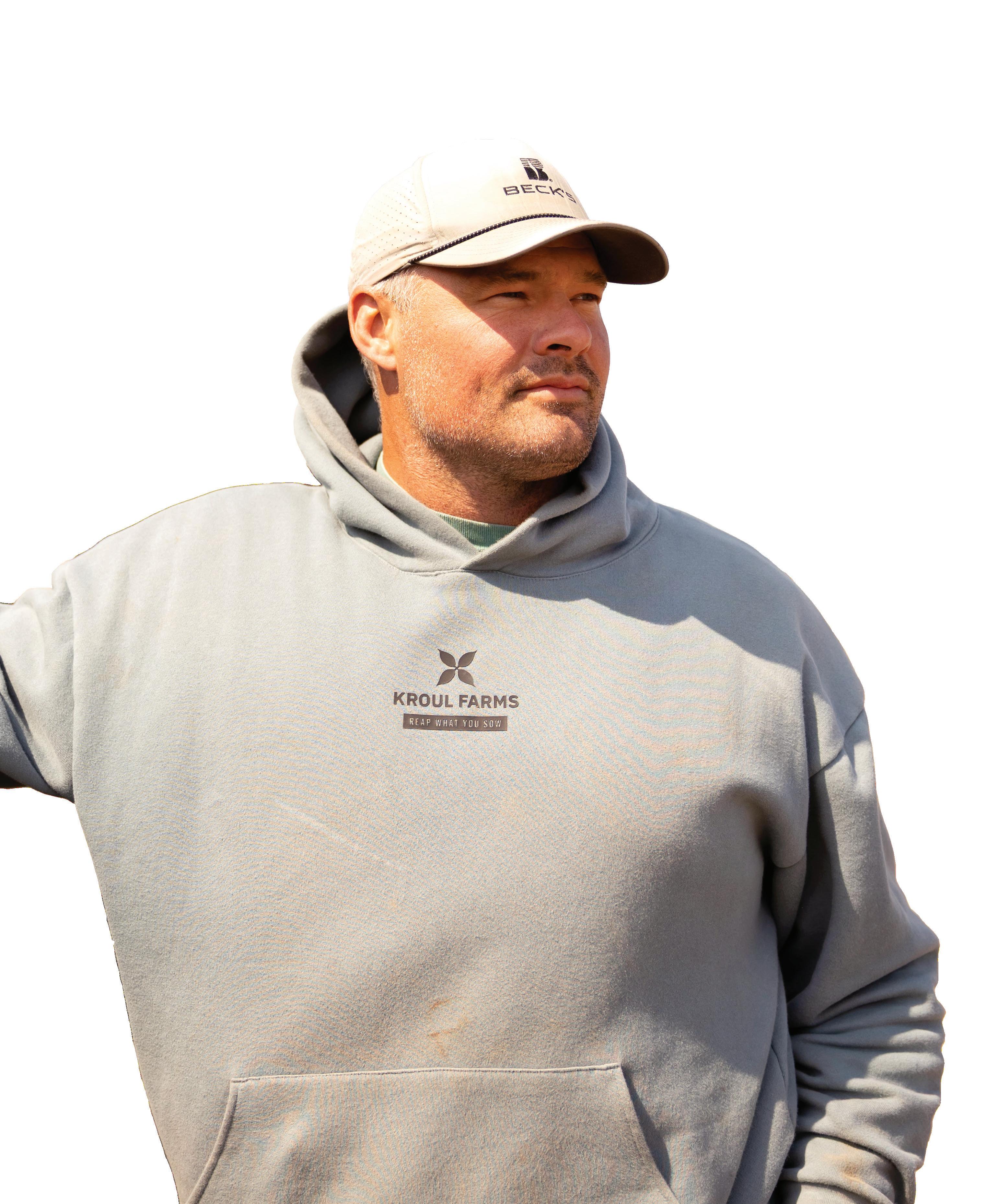



By Gretchen Westdal Centers
In an outbuilding on Highway 1 in Mount Vernon, settled between acres of sprouting corn and soybeans, Matt Kroul takes a rare break. He’s on the phone with his business partner and wife, Nicole, navigating the logistics of being interviewed for a story. Juggling marketing plans and business administration tasks for the farm, Nicole directs Matt to where he can find the interview link.
Their conversation is full of fits and starts — neither one needing to finish a sentence, as the other already knows what’s coming. It’s a familiarity born of hours, days, months and years working side by side to build the life that led them to Kroul Farms.
They met in their early days at the University of Iowa: two small-town farm kids who, in between helping on their families’ operations, were deeply involved in high school sports. That early pull between two passions would become a common thread throughout their lives.
Matt was a starting defensive lineman for the Hawkeyes, and Nicole was active in student organizations. Their time at Iowa was devoted to what they were most committed to: school, football and one another. It paid off.
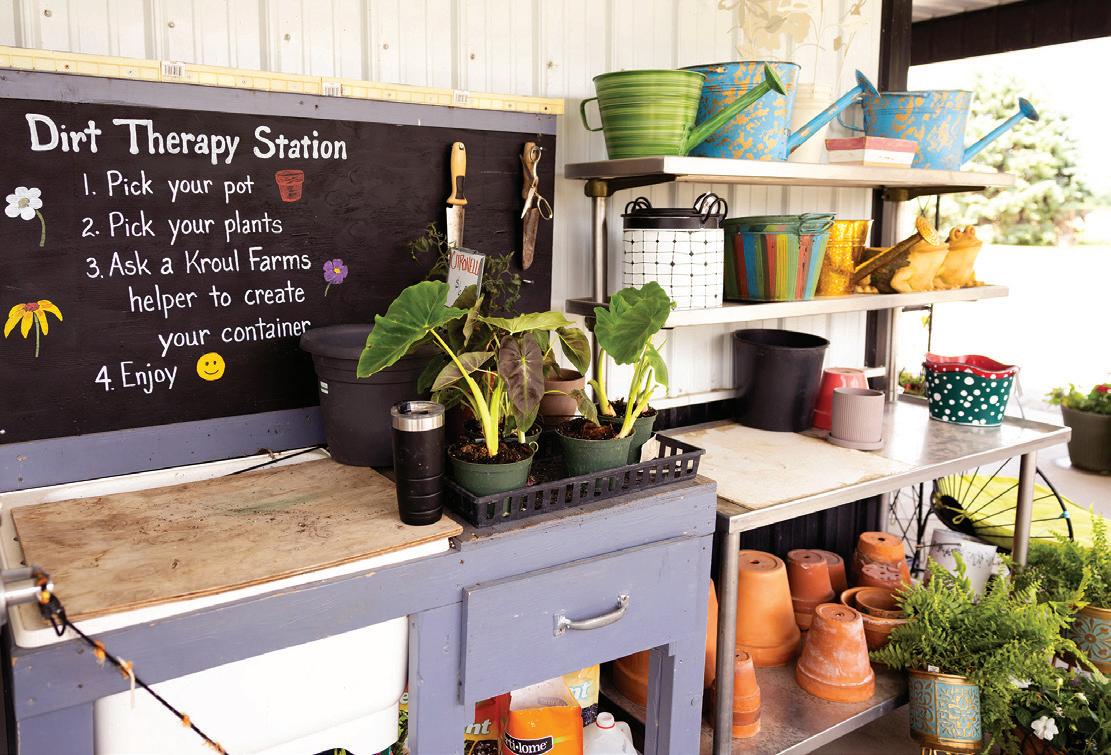




After college, Matt was drafted into the NFL, from the Hawkeyes to the New York Jets. From the comfort of Iowa City to the hustle of New York City, they were in it together. They stayed out east for about a year before returning home, starting a family and getting back to farming.
“You never want your time playing a game to end,” Matt says. “Athletics were always a part of my life; my parents let me focus on that. I was able to take football as far as I could, and I saw the opportunity here, at the farm, to turn this into something bigger.”
IN ADDITION TO TRADITIONAL FARMING OPERATIONS, THE KROULS INVITE THE COMMUNITY TO TOUR THEIR FARM, ATTEND SEASONAL EVENTS AND PICK PUMPKINS IN THE FALL.
“I think once you started down that path of farming fulltime, you were kind of hooked,” Nicole adds with a smile.
Together with Matt’s parents, John and Kaylene, the Krouls own and operate a diversified farm that produces corn, soybeans, pumpkins, a wide variety of seasonal vegetables — including sweet corn — flowers, firewood and raise cattle and chickens for beef and eggs. They also offer a Community Supported Agriculture (CSA) program, allowing customers to receive farm-fresh produce delivered straight to their doors.
In addition to traditional farming operations, the Krouls invite the community to tour their farm, attend seasonal events and pick pumpkins in the fall. It’s a busy and demanding life. But, like many farmers, they don’t shy away from hard work.
“Early March is when things really start to ramp up,” Matt explains. “We’re always doing something, but early spring is go-time. We fire up the greenhouses, getting all the flowers in. We start all our vegetables from seed. We run about 140 head of beef cows and have a cow-calf operation, so we start calving around March 15. Firewood is year-round now — it used to be just in winter — but we have quite a few bundling contracts. And then there are the flowers and opening the farm to the public.”
Kroul Farms opens when the spring weather cooperates each year and runs through October 31. Nearly 30 years ago, Matt’s parents began welcoming visitors to pick pumpkins, and people have been coming ever since. Spring and summer are filled with kids and adults learning about farm life and filling baskets with fresh flowers and produce. Fall features a corn maze, an expansive pumpkin patch, spooky sights and festive fall decorations. Throughout the year, beyond the



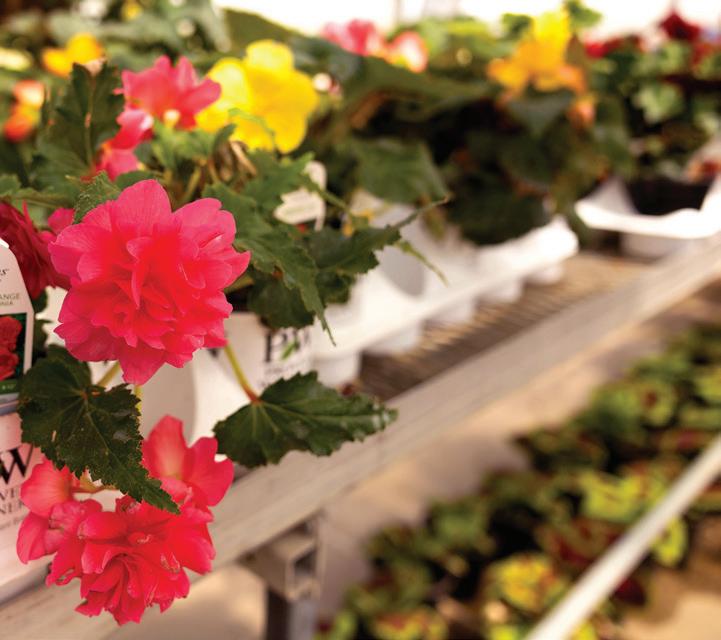
The farm operates a Community Supported Agriculture (CSA) program, delivering fresh, locally-grown produce to subscribers throughout the growing season.
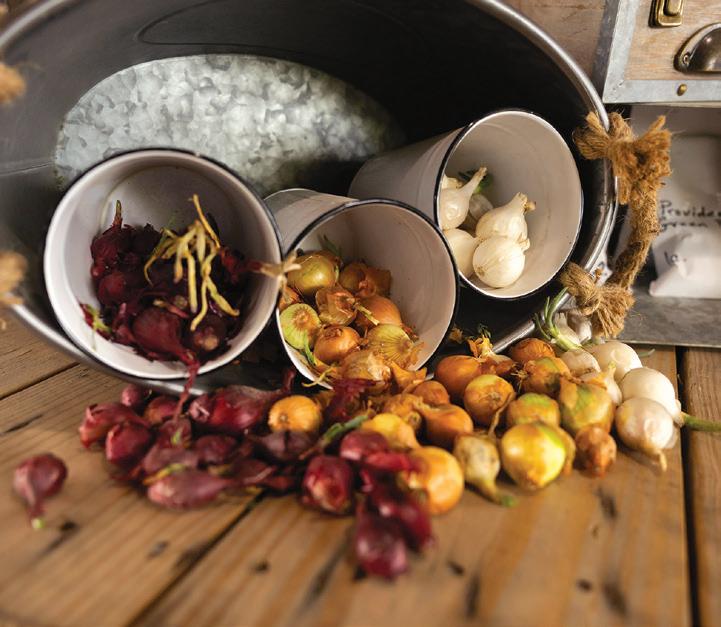
For Matt and Nicole, farm life is about more than crops and chores. It’s about teaching


day-to-day farming, the Krouls host dinners and community groups to share the fruits of their labor and celebrate togetherness.
“We walk a fine line between maintaining a traditional, working farm and offering experiences visitors may enjoy,” Nicole says. “We wrestle a little bit with how much extra to do because it’s so important for people to understand where their food comes from, how we produce it and what farms do. Some places have a

LIKE MANY FAMILY-RUN FARMS ACROSS IOWA, THE KROULS LOOK TO THE FUTURE WITH OPTIMISM AND REALISM.
farm feel but are purely for entertainment. The more we try to compete with that, the less successful we will be.”
So, they forge their own path — doing what works for their farm and community. That community often connects back to athletics. In July 2024, Kroul Farms hosted the Big Ten Life Experience Series, welcoming student-athletes, coaches and staff to learn about the business and practice of farming. Participants planted produce and flowers and collected eggs.
Nicole explains that they love seeing families, school groups and people of all ages enjoy the farm while learning about and interacting with the work that keeps it running. They’ve never charged admission, honoring their commitment to making farm education accessible to everyone. It’s not always easy — but then again, when is farming ever easy?
Kroul Farms also includes 550 acres of traditional row crops, which Matt, his dad, brother, and their employees manage. Corn and soybeans make up much of the yield. About 235 acres of soybeans are rotated to support soil conservation. After harvest, the Krouls plant a rye-clover cover crop, which not only aids in field restoration but also feeds their cattle. They’re committed to sustainable and responsible farming practices, using no-till methods, repairing buffer zones and participating in conservation reserve programs, ensuring the land remains fertile and healthy for the next generation.
Like many family-run farms across Iowa, the Krouls look to the future with optimism and realism.
“We want to expand on the legacy created by my parents and their parents,” Matt says. “They’ve been farming for 40 years and have their way of doing things. It’s helped spark an entrepreneurial spirit in us to build on what they’ve done. We want to balance the past with the present. Sometimes, we’ve got to remind them of the risks they took. It’s one thing to be a family business. It’s another thing to be a family farming business.”
“It’s not for the faint of heart,” Nicole adds. “We’re all focused on growing the business using our strengths and staying committed to what has worked — and what will work best for our family and the farm.”
Matt and Nicole continue exploring new ways to welcome visitors to the farm while maintaining sustainable practices, hoping one of their four children might one day carry on the legacy.
“We continue to adapt and grow,” Matt says as he heads back to work. “In the next 10 to 15 years, around 60% of farmland will change hands. It’s going to be a major transition — not just for Iowa, but for the entire Midwest. We want to be ready for that. That’s the number one thing. Amid all the chaos, Nicole and I have to celebrate what’s working and stay open to the possibilities of what we can do next with this land that’s ours.”

In 2019, Matt Kroul was inducted as the eighth honoree into the Iowa Farm Bureau’s America Needs Farmers (ANF) Wall of Honor. ANF, created by legendary Iowa Football Coach Hayden Fry, is a commitment to Hawkeye players, fans and Iowans to recognize the necessity and resilience of farmers.
Born out of the 1980s farm crisis that deeply affected Iowa families, ANF became a symbol of support. Fry, who coached at Iowa from 1979 to 1998, witnessed firsthand farmers’ hardships. In 1985, he wanted to help and introduced ANF on his players’ helmets to raise awareness. That symbol helped elevate their struggles.
Today, ANF supports the fewer than three percent of Iowans who farm, lifting their voices and encouraging innovation and efficiency to sustain their livelihoods for future generations.

By Lydia Zerby




Ready to kick back and soak up summer? We’ve got the perfect lineup for easygoing eats with serious flavor. Think sticky-sweet pork ribs, smoky turkey burgers and a cool, creamy scoop of blueberry cheesecake ice cream. Whether you’re firing up the grill or chilling on the patio, these Iowa-inspired recipes bring the fun — and the yum.
• 4 pounds pork back ribs
• 1 cup reduced-fat French dressing
• 2 tablespoons dry onion soup mix
• 2 tablespoons honey
• 1 tablespoon low-sodium soy sauce
Preheat the grill to 350 degrees F or medium heat. Clean and oil the
cooking grate, then close the lid.
In a small bowl, combine dressing, soup mix, honey and soy sauce. Mix well and set aside.
Season ribs with salt and pepper.
Grill the ribs for 1.5–2 hours until tender,

or until the internal temperature reaches 170–180 degrees F.
Brush ribs with sauce during the last 15–30 minutes of cooking. Serve remaining sauce with ribs.

Whole muscle pork cuts are safe to eat when cooked to 145 degrees F and allowed to rest for 3 minutes.
• 1 cup blueberry pie filling
• 1 package (8 ounces) cream cheese
• 1 can (14 ounces) sweetened condensed milk
• 2 cups heavy whipping cream, cold
• 1 cup graham cracker crumbs
Add the blueberry pie filling to a food processor and blend until smooth. Set aside.
In a large bowl, mix the cream cheese until smooth. Mix in the sweetened condensed milk and set aside.
In another large bowl, beat the heavy whipping cream until stiff peaks form. Fold in the sweetened condensed milk mixture and 1/3 cup of the pie filling.
Pour half of the ice cream base into a loaf pan. Spoon half of the remaining pie filling and half of the graham cracker crumbs on top and swirl with a butter knife. Repeat with the remaining ice cream, pie filling and graham cracker crumbs.
Freeze for 6 to 8 hours.


Try using different flavors of pie filling such as cherry, strawberry or raspberry.
TURKEY BURGERS
• 1 pound ground turkey
• 1 tablespoon fresh cilantro, chopped
• 1/2 tablespoon jalapeno pepper, seeded and chopped
• 1/4 teaspoon freshly ground black pepper
• 4 hamburger rolls, split and lightly toasted
TOMATO SALSA
• 10 cherry or grape

tomatoes, seeded and quartered
• 1/4 cup yellow bell pepper, seeded and diced
• 2 tablespoons scallions, chopped
• 11/2 tablespoons lime juice
• 1/4 teaspoon salt
• 1 tablespoon fresh cilantro, chopped
• 1/2 tablespoon jalapeno pepper, seeded and chopped
FOR THE BURGERS
In a bowl, gently mix ground turkey with cilantro, jalapeno and black pepper. Shape into 4 patties, about 1-inch thick.
Grill patties about 4 inches from the heat source. Turn once, and cook until the internal temperature registers 165 degrees F, about 5 minutes per side.

FOR THE SALSA
Combine tomatoes, bell pepper, scallions, lime juice, salt, cilantro and jalapeno.
ASSEMBLY
Place cooked turkey burgers on toasted rolls and top evenly with tomato salsa.
Photo and recipe credit: National Turkey Federation
Our broadest conception of success is measured by the influence for good with our neighbors. With roots firmly embedded in the rich soil of sincerity, truth and love for one another.”
By April Pearson

When Pete and Lucille Kuyper invested in the revolutionary Rolscreen retractable screen in 1925, they opened a window into the future of American manufacturing. The Rolscreen redefined how windows worked, improved customers’ lives and launched a legacy of innovation. It also marked the beginning of a company built on traditional American values, like integrity, craftsmanship and a people-first culture.
Pete took the Rolscreen and rolled with it, founding Pella Windows & Doors in 1925 in the small Dutch community of Pella. He once said that a prosperous business must have values and cultures rooted in the past, but also must compete aggressively in the future. Pella continues to embrace this philosophy 100 years later by focusing on workforce development, community connection and product innovation.

“Pete began the company to create great jobs in his hometown. From the beginning, everything he did was built on caring for people," says Karmen Gardner, vice president of corporate communications and employee experience for Pella Corporation. “That purpose lives on today in how we make life brighter for our customers, team members and communities. We imagine what’s possible and build it together. It’s what’s fueled us for 100 years.”
Pete believed in creating jobs in local communities to benefit employees and improve local economies. Pella has four manufacturing facilities in Iowa and 14 more across the U.S. The individuals operating those plants are encouraged to come up with ideas that improve the lives of homeowners, solve problems for builders and make production more efficient.
“Our workers take so much pride in their craft and ability to grow


and change,” says Gardner. “As you can imagine, over 100 years, they’ve had to adapt their skills to new technology. We’re huge believers in continuous improvement, and you see that in our plants.”
She also says that an important part of creating jobs is being competitive with benefits and pay, and cultivating a culture in which people can thrive.
When Pella hired women to fill the workforce gap during World War II, the company paid them the same as the men — a revolutionary business practice, even today. More recently, Newsweek named Pella one of “America’s Greatest Workplaces for Women,” and Forbes named it a "Best In-State Employer.” For decades, Pella has strived to attract and keep the best.
“Pella is all about building a talent advantage,” says Gardner. “We believe that we have the best people in the industry, and to have the best people, we have to invest in our people. We have to ensure that our company is operating as an inclusive organization where everyone, from all walks of life, can bring their ideas to the table and contribute to their fullest. That’s how you build a talent advantage, and that’s what we’re doing here at Pella Corporation.”
Pella employees care a lot — and not just about their craft. “They also really care about our customers, each other and the places they live,” says Gardner. “Investing in our people pays off because they’re contributing their talents, time and resources to society.” Last year alone, Pella employees volunteered 17,000 hours in their local communities.
Pella Corporation is dedicated to making an impact at the local level. For example, in the past five years, the company has invested $35 million in housing, restaurants, playgrounds, parks, social services and childcare in the town of Pella. “We make important investments based on specific needs,

KARMEN GARDNER “
We imagine what’s possible and build it together... ”
ensuring that our communities are growing with us and that we’re equally thriving together,” says Gardner.
Pella’s generosity extends to hundreds of worthy organizations around the world. The Rolscreen Foundation has a matching gifts program that doubles team members’ contributions to nonprofits, with over $325,000 matched in 2024 alone. Its volunteer grant program donates $100 for every 20 hours an employee volunteers, up to $1,000 per year. Named after Lucille and Pete’s daughter, the Joan Kuyper Farver Spirit Award recognizes compassionate workers by donating $25,000 to the winner’s favorite charity, with finalists also receiving grants to charities of their choice. Pella also partners with schools and offers scholarships to empower individuals, expand access to education and help bridge the skills gap.
Fast Company named Pella one of the “Best Workplaces for Innovators in the U.S.” and one of the “Most Innovative Design Companies.”
Pella was founded on an innovation that revolutionized the market 100 years ago: the Rolscreen. Since then, Pella has had a rapid succession of industry firsts, including blinds between the glass, foldaway handles and hidden screens. “In recent years, we’ve doubled down on innovation,” says Gardner. “Our latest innovation is what we call the Steady Set system, and it’s going to change the industry.” Designed with the
17,000
builder in mind, this awardwinning interior installation system makes installing heavy windows quicker and safer.
Pella’s dedication to innovation includes embracing sustainability and efficiency. “Pete championed being good stewards of the business and being good stewards of our environment,” says Gardner. Legend has it that when Pete was running the company, employees would have to check in their old, stumpy pencil before they could get a new one. In keeping with Pete’s spirit of sustainability, Pella practices responsible forest management, maximizes recycling, minimizes pollution, reduces energy consumption and produces windows and doors that are built to last.
As Pella celebrates its 100year history, it’s also looking to tomorrow. "We have the best team in the industry, a pipeline of award-winning innovations and high-quality products that stand the test of time,” says Gardner. “Only 1% of companies ever make it to 100 years, so we are absolutely celebrating — but we’re also looking at it as a mile marker. The best is yet to come.”
Employees commemorate Pella Corporation’s 100th anniversary, celebrating a century of innovation and community impact.

By Aaron Putze, APR
Energy is a lot like the air we breathe. We all need it, but rarely think much about it.
Like electricity, the fuel we need to travel to our various activities, commitments and to spend time with loved ones is largely out of sight and out of mind.
Nearly 92% of passenger vehicles operating in the U.S. still rely on liquid fuels. The cost of electric vehicles, lack of charging stations and environmental concerns related to battery production and disposal remain challenges for the electric vehicle market.
In the meantime, liquid fuels continue to provide most of the horsepower Americans need to live, work and play. Just about everything that moves, lifts, pulls, carries and tows is powered by liquid energy. In greater amounts, this fuel is produced using co-products from soybeans and corn, thereby reducing the need for petroleum, benefiting the environment, human health and enhancing rural economies.
Iowa farmers acted on the possibilities. Soybeans and corn, which are abundant in large supplies, contain ingredients that can produce oils perfect for blending into the nation’s fuel, thereby optimizing our energy supply.
Corn is a suitable biofuel feedstock due to its high starch content and its relatively easy conversion to ethanol. The coproduct of ethanol production is dried distillers grain (DDGs). Rich in protein, fiber, germ, vitamins and minerals, DDGs are ideal for cattle and livestock feed.

Clean fuels like biodiesel create incremental greenhouse gas emission reductions.
Petroleum long served as the primary ingredient for liquid fuel. Then came the 1970s. With political unrest in oil-producing regions threatening supply and the phase-out of lead in gasoline, interest in using biofuels as a potential octane booster increased. By 1986, lead was no longer allowed in motor gasoline. A preference quickly grew for locally produced and readily available ingredients that would burn cleaner and reduce CO2 emissions and other harmful substances.
Soybeans are also a widely available ingredient for liquid fuels. Last year, U.S. farmers grew 4.3 billion bushels of soybeans. Iowa, the nation’s secondleading producer of soybeans, accounted for almost 14% of that total, or 600 million bushels.
The legume consists of two primary substances: oil and protein. The latter, processed into soybean meal, was long considered the most valuable of the two, given its popularity as an ingredient for pig, poultry, dairy and, more recently, fish feed.
Over time, soybean oil production far outpaced demand. With the soybean processing created for animal and aqua feed, the oil byproduct often risked going to waste.
“Rather than discarding the oil or having it sit and spoil, farmers explored other uses, including fuel,” says Grant Kimberley, a Maxwell farmer and Iowa Soybean Association market development and
biofuels advocate. “Farmers put forth their own money to research the possibilities, including its use as an industrial fuel.”
While corn gave rise to ethanol production, soybeans quickly became a viable ingredient in the production of diesel fuel. Together, these two types are collectively referred to as biodiesel. Referred to as a “drop-in fuel,” biodiesel can be used by all existing diesel engines.
“These are the engines that build, produce and transport nearly all the products people consume,” says Kimberley. “Without them, nearly every product people need would be scarcer and more expensive.”
Carbon emissions resulting from the burning of fossil fuels are a leading contributor to greenhouse gas emissions. Over time, these emissions create a greenhouse gas effect that impacts the weather and increases the risk to human health.
It’s not just farmers singing the praises of biodiesel.
The American Lung Association recognizes biodiesel as a Clean Air Choice® alternative fuel. The designation is due to its proven ability to reduce harmful emissions and support healthier communities.
Derived from renewable resources like excess soybean oil, biodiesel has proven to offer better performance, immediate cost savings, lower emissions and positive economic impact when used as a replacement for petroleum-based fuel.
Studies show that replacing traditional diesel fuel with 100% biodiesel can have a sizeable impact on human health while reducing carbon emissions by as much as 70%, and cleaner air means healthier, more equitable communities.
A study completed for Clean Fuels Alliance America by Trinity Consultants found that pure biodiesel (also called B100) could reduce pollution in legacy heavyduty transportation and residential heating – two of the most difficult applications to decarbonize.
The following annual health benefits were identified:
• More than 457,000 fewer asthma cases
• More than 177,000 fewer sick days
• The prevention of more than 1,100 premature deaths
• More than $7.5 billion in avoided health costs
• A 45% reduction in cancer risk when legacy heavyduty trucks use B100 (100% biodiesel) and an 86% reduction when Bioheat® fuel is used for home heating.
“Biodiesel is a practical, available solution that helps to improve air quality right now,” said Bailey Arnold, Director of Healthy Air Solutions at the American Lung Association. “From transit buses to over-theroad trucks to municipal equipment, switching to biodiesel immediately reduces harmful pollutants and benefits public health, especially in communities disproportionately impacted by heavy-duty vehicle emissions.”
Switching to 100% biodiesel generates $7.5 billion in avoided health costs annually. These findings were based on a mere sample of communities across the country. Now, just imagine the benefits if biodiesel was adopted nationwide!
Biofuels generally fall into two categories, bio-alcohol and biodiesel. The former, such as ethanol, is created through fermentation, using yeast and bacteria to break down starches and sugars from corn and other plants. Scientists are also developing technologies that allow bio-alcohol instead of cellulose and hemicellulose, the non-edible fibrous material that makes up the bulk of plant matter. Several commercial-scale cellulosic ethanol biorefineries are already in operation.
Biodiesel, on the other hand, is created in refineries that use new and used vegetable oils and animal fats, such as recycled cooking grease. These oils are then treated with alcohol and converted to biodiesel.
Clean fuels like biodiesel create incremental greenhouse gas emission reductions by reducing the carbon emissions of diesel engines by more than half.
“If you start with the goal of improving the environment, then biodiesel is the smart choice,” says Dave Walton, a soybean farmer from Wilton.
Biodiesel also virtually eliminates the particulate emissions from those engines, he adds. That’s a significant health benefit for those living and working in areas where diesel engines are concentrated, such as freight terminals, ports and highways.
Aimee Bissell, a farmer from Bedford, highlights the health benefits of using energy derived from locally produced products, such as soybeans.
“As a respiratory therapist for over twenty years, I worked tirelessly to assist patients with breathing issues,” she says. “Now, as a farmer and user of biodiesel, I’m delighted to report that the use of the product we grow and help produce is having a positive impact on citizens’ health.”
Research from the American Lung Association backs Aimee’s perspective. The American Lung Association recently recognized biodiesel as a Clean Air Choice alternative fuel. The designation is due to its proven ability to reduce harmful emissions and support healthier communities.
“In addition to biodiesel having a significant impact on the environment in Iowa and around the world,
“As I reflect on the topic of biofuels, I can’t help but be reminded of the spectacular role we as farmers play in making our backyard and environment cleaner. The agriculture community is creatively awesome!”
AIMEE BISSELL, FARMER NEAR BEDFORD
What
OK, it’s time to channel your inner botanist! A legume is a plant from the Fabaceae family. It includes their leaves, stems and pods. The edible seed from a legume plant is called a pulse. Beans, lentils and peas are popular varieties of pulses. Legumes are commonly grown for human consumption, livestock feed and soil improvement.
the use of soybean oil for biodiesel makes food more affordable,” says Bissell.
When processing soybeans for their protein, oil is extracted and further refined for use in human nutrition, food preparation and as a food ingredient. The added value of using the oil differently means more soybeans are processed, thereby increasing the supply of soybean meal. Following the basic laws of supply and demand, the cost of soybean meal decreases.
Given feed is the costliest input for livestock, poultry and dairy producers, lowering its price means animals can be fed and raised more economically. These savings are passed on to consumers in the form of lower prices in the meat case.
So, rather than viewing it as a choice between food and fuel, as some argue, farmers see it as a combination of both.
The demand for oil in the food sector has been virtually stagnant over time, says Walton. As demand for soybean meal increases, more oil is also produced.
so, rather than food vs. fuel, as some argue, farmers see it as food and fuel.
“As the oil value increases, it allows the meal price to decrease. That, in turn, lowers the feed cost to our biggest customers,” says Walton. “Want to fire up that grill this summer and enjoy some pork chops or barbecue chicken, but worried about the price? The demand for oil, via biodiesel, can help lower the food cost.”
“Biodiesel refiners are using that excess oil, and it isn’t taking anything away from the demand that food companies have for that same oil. We can truly have both — better fuel and more affordable food.”
Biodiesel production also benefits Iowa economically.
“It adds $700 million per year to the value of the soybeans we grow in Iowa,” Walton says.
The positive impact of this added revenue is particularly acute in rural communities where biodiesel processing facilities are located.
“Biodiesel plants are often located in small rural communities and provide stable, high-paying jobs, increasing the tax base in those small communities,” Walton adds. “Keeping those jobs in small towns allows them to remain stable and prosperous while making our air cleaner and food more affordable.”
By Leah Brooke

Leah Brooke, a lifelong resident of Southwest Iowa, has a deep-rooted connection to agriculture. Raised on a family farm with row crops, cattle and hogs, she has come full circle in her journey. Now, as a registered dietitian nutritionist, Leah combines her agricultural background with her expertise in nutrition, understanding how farm-raised products contribute to our overall health and well-being.
According to the USDA, food waste costs an American family of four $1,500 annually. Often, it’s not intentional, but this is a price many cannot afford, especially with rising food prices. An abundance of food can be a happy accident, however. Knowing how to safely and easily share food with family, friends and the community can be a benefit for all.
This scenario happened to me last summer when I was a first-year garden enthusiast. I planted way too many seeds and plants and was so afraid I wouldn’t have a green thumb. In the late summer months, I found myself with buckets and buckets of zucchini, yellow squash and tomatoes.
If you’ve found yourself in a similar situation, even after the extras have been given to friends and family, I have a solution: a community fridge! You’re not alone if you don’t know what they are. I hadn’t heard of them until just a few years ago, and my town just got a community fridge. It has been a blessing, and I can’t wait to drop off my extra food this summer.
A community fridge is a space where people can take what they need and leave what they can. It is a community resource meant to help our neighbors and reduce food waste. There are some important rules to know when using the fridge.
Be sure to donate food that is fresh and before the use-by date. Food should only be donated because it is no longer needed, not because it isn’t edible. Food needs to be adequately sealed to prevent contamination, and no partially eaten food should be donated. Anything prepared or homemade should have the preparation date on it. There should also be a seven-day throw-away rule on any prepared item. Best practices would also be labeling ingredients used in the item and removing spoiled food immediately.
A few other food safety-related items to keep in mind are to prepare homemade food in a clean kitchen. Be sure to cook hot foods to the appropriate minimum internal temperature and keep cold food at 41 degrees F or below. Any leftovers

AND INNOVATIVE PRACTICES CAN HELP REDUCE FOOD WASTE EFFECTIVELY.
that will be donated shouldn’t sit out at room temperature for more than two hours. Donating food that is safe for everyone to eat is important; these simple steps can keep everyone healthy.
Finally, here are some tips on how you can help reduce food waste and be a part of the change. Regularly clean
and organize your refrigerator, freezer and pantry to use the oldest items first. If you aren’t sure how long things will last or how long they are good for, download the FoodKeeper App and learn about safe handling, preparation and storage of food and beverages. Understanding food date labels is also critical to reducing waste and staying safe. Except for infant formula,
food dates are not indicators of food safety, but rather a way for manufacturers to help retailers and consumers decide when the food is at peak quality.
I encourage you to keep donating excess produce and food, and do it safely. See if your neighborhood has a community fridge or help start one and give food a second life.


FIND UNLEADED 88 AT A STATION NEAR YOU
Unleaded 88 is a fuel choice that’s cheaper, better for the planet, and it’s homegrown. At your next gas station stop, don’t just fill up. Pump it Up with Unleaded 88, and cue the dance moves.